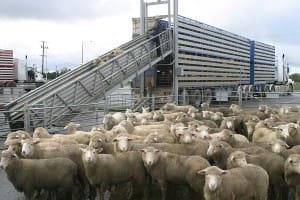 AUSTRALIA’S livestock transport standards have been reprinted in the latest edition of the ‘Is It Fit to Load’ guide.
AUSTRALIA’S livestock transport standards have been reprinted in the latest edition of the ‘Is It Fit to Load’ guide.
The guide was recently reprinted. Copies can be downloaded from the Meat & Livestock Australia website here or are available from state farming organisations.
A joint statement from the Sheepmeat Council of Australia and WoolProducers Australia said adhering to the criteria of the guide is one of the many ways Australian sheep producers and wool growers can demonstrate they are serious about sheep welfare.
The guide was developed to provide guidance to the livestock industry on whether an animal is in a condition fit to be loaded to undertake a journey by road, rail or ship to a particular destination. The national standards were developed by industry, welfare organisations and government and are regulated by state and territory governments.
The guide is designed to help producers, livestock agents, buyers and transporters meet their legal obligations under the Australian Animal Welfare Standards for the Land Transport of Livestock and help to ensure high animal welfare standards are maintained throughout the livestock industries.
Topics in the guide include preparation of livestock for transport, feed and water, examples of animals that are unfit to load and what to do if an animal is unfit to load.
It is the responsibility of the person in charge to ensure that animals are prepared correctly, will cope well with the entire journey and are not suffering any illness or injuries. An animal is not fit to load if it:
Is not strong enough to take the journey
Cannot walk normally bearing weight on all legs
Is severely emaciated or visibly dehydrated
Is suffering from severe stress or injury
Is in a condition that could cause pain or distress during transport
Is blind in both eyes
Is in late pregnancy.
Transporting unfit animals not only reflects poorly on the person in charge of the animals but on the wool and sheepmeat industries. It is a reminder that there is a joint responsibility for animal welfare and it is imperative that all animal welfare obligations are being met. Sheep in transit are highly visible – it only takes a few moments for someone to upload what they see to the rest of the world – if all livestock are ‘fit to load’, the reputational risk to the Australian industry is reduced.
The Sheepmeat Council of Australia and WoolProducers Australia work with all industry stakeholders to improve animal health and welfare at all stages of the supply chain and support this work through research, development and extension.
Click here to read the Fit to Load Booklet.
Source: Sheepmeat Council of Australia, Woolproducers Australia.



Hi, How can I obtain the Fit To load booklet? My address is: David Hosking, “Valleyfield”, 2450 Northern Highway, Moranding, Vic 3764.
Editor’s note: David, I have updated the story with a link to the booklet.